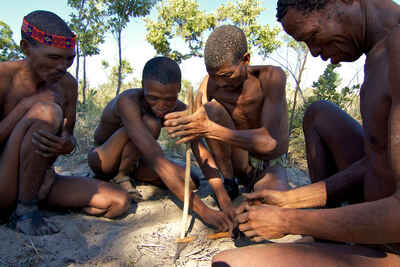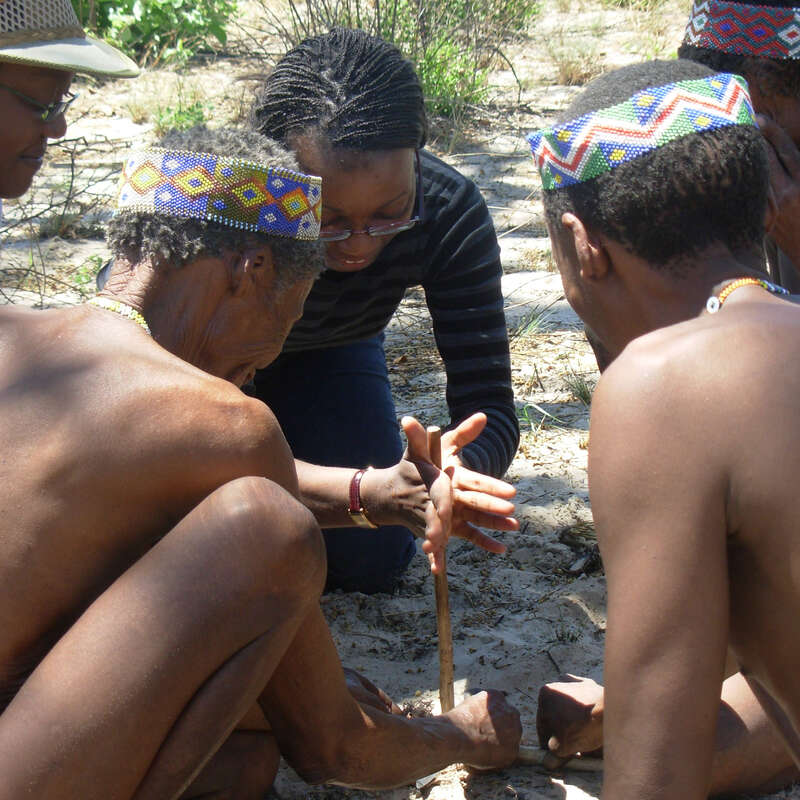About Nhoma Camp
Nhoma Camp, located close to Khaudum National Park, is a small, tented camp in a remote area of north-eastern ...
... Kalahari, known as Bushmanland, which takes its name from the nearby village of //Nhoq'ma. New owners, Belgian Flora Blommaert and Namibian Moritz von Hase, took over from Arno and Estelle Oosthuysen in January 2021 and, together with their young child Indigo, have made Nhoma Camp their home and the Bushmen their business partners and neighbours.
Nhoma Camp is in a remote location, so stay for two nights or more. It’s a chance to participate in village life in a sensitive yet authentic way, and learn about a hunter-gatherer culture that is totally unlike our own. This can be a unique and incredible experience, but what you get out of it will depend very much on your approach to your time with the Bushmen.
Our view
Nhoma Camp is in a remote location, so stay for two nights or more. It’s a chance to participate in village life in a sensitive yet authentic way, and learn about a hunter-gatherer culture that is totally unlike our own. This can be a unique and incredible experience, but what you get out of it will depend very much on your approach to your time with the Bushmen.
Accommodation
10 Tents
Children
Best for 8+
Open
All year
Activities

4WD Safari

Birdwatching

Cultural excursion

Private activities
Traveller reviews of Nhoma Camp
42 real, un-edited reviews from Expert Africa's travellers.
Arrived 3 Oct 2024, 2 nights
"Nhoma Camp review"
Overall rating: Excellent
Arrived 10 Sep 2023, 2 nights
"Nhoma Camp review"
Overall rating: Excellent
Arrived 25 May 2022, 3 nights
"Nhoma Camp review"
Overall rating: Excellent
Arrived 24 Jan 2020, 3 nights
"Wildest of the wild."
Overall rating: Good
Arrived 7 Oct 2019, 3 nights
"A great experience"
Overall rating: Excellent
Arrived 26 Feb 2017, 3 nights
"Nhoma camp."
Overall rating: Good
Arrived 2 Oct 2016, 2 nights
"Great experience to visit the bushmen"
Overall rating: Good
Arrived 2 Nov 2015, 2 nights
"Nhoma Camp review"
Overall rating: Good
Arrived 29 Aug 2015, 3 nights
"Nhoma with the Bushmen"
Overall rating: Excellent
Arrived 7 May 2015, 3 nights
"Nhoma Camp"
Overall rating: Excellent
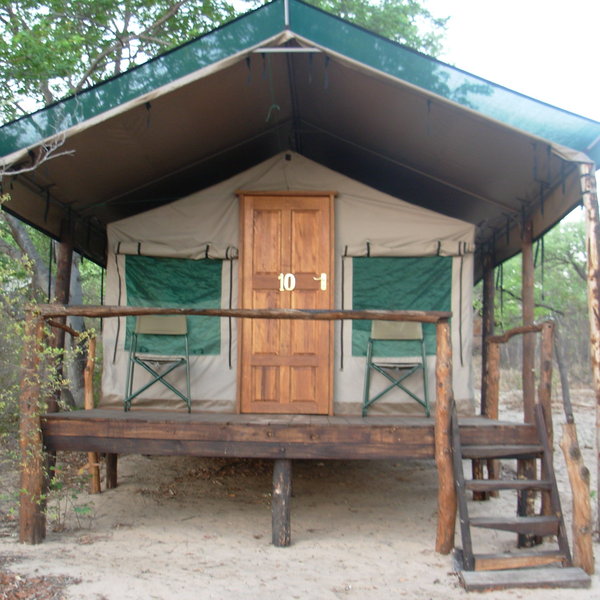
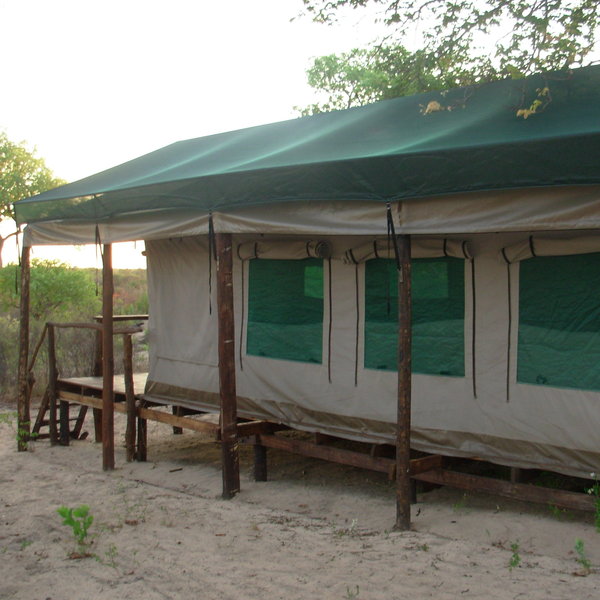
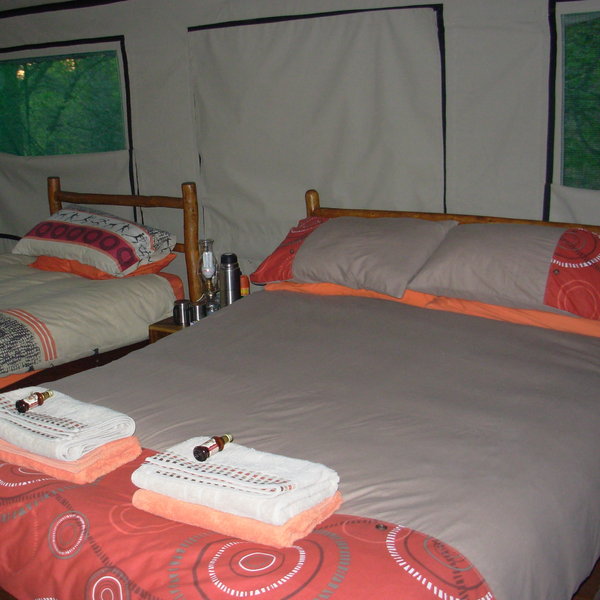
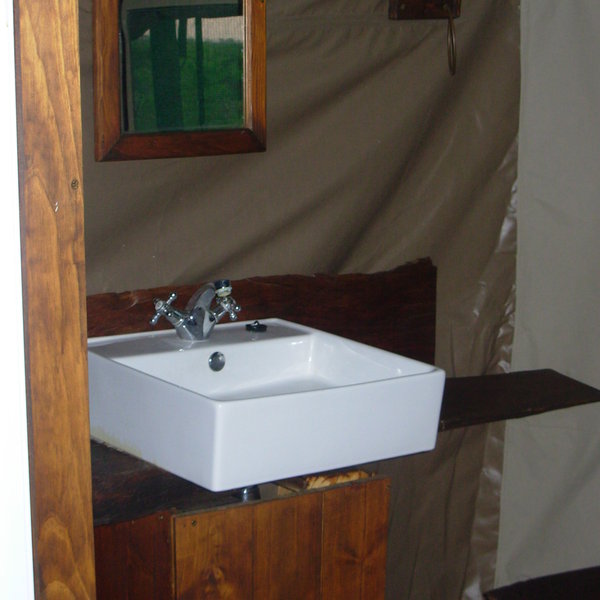
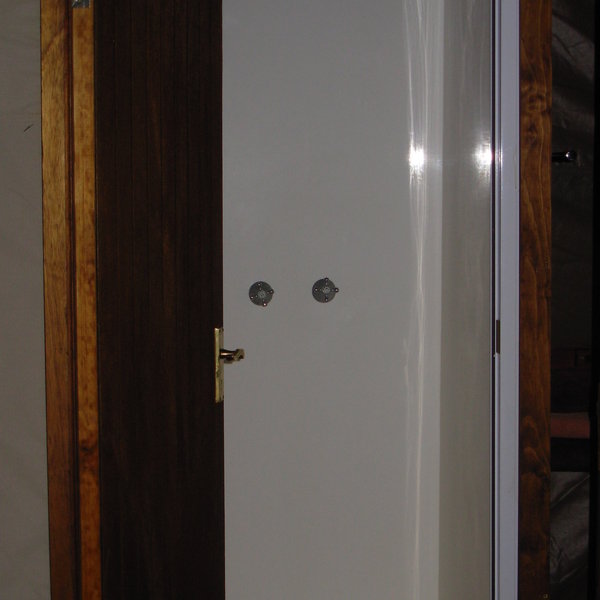
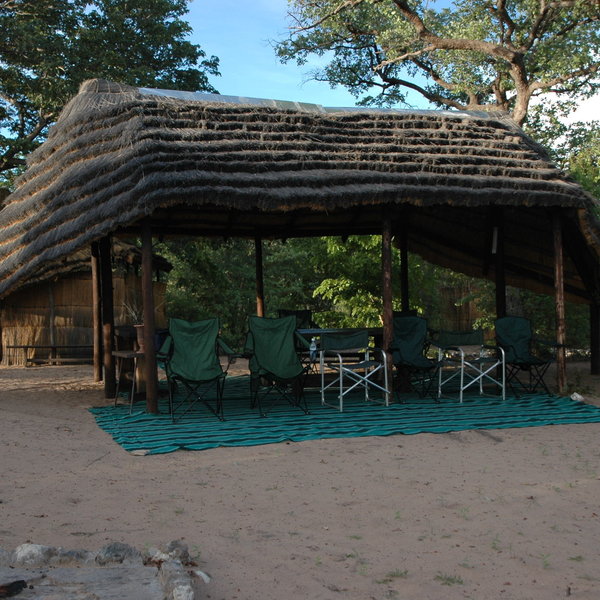
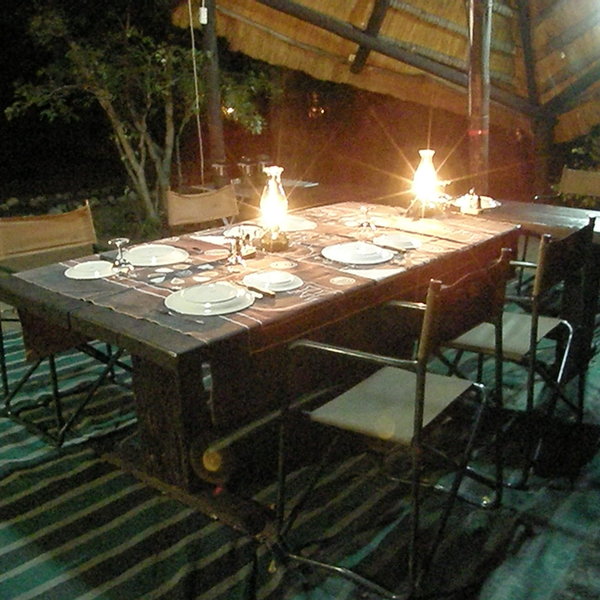
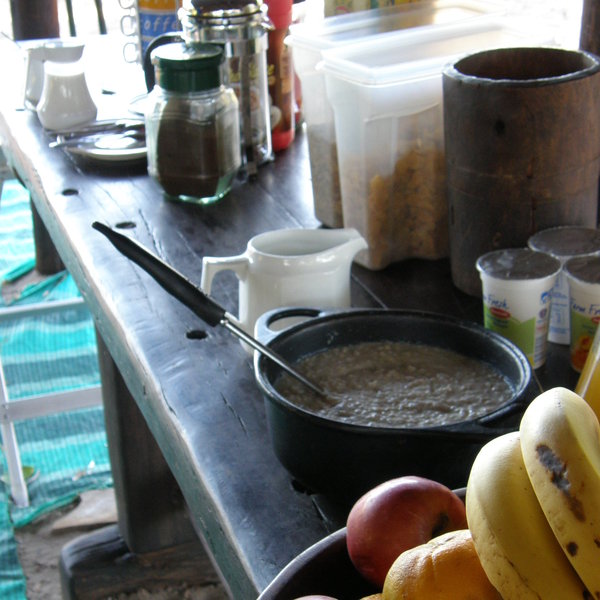
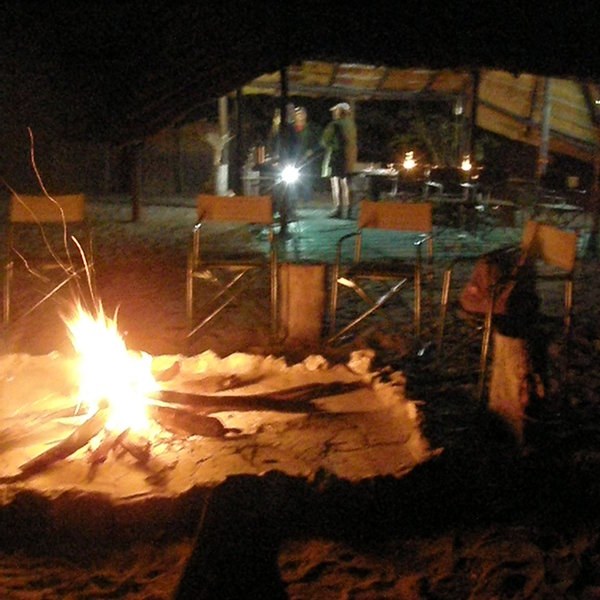
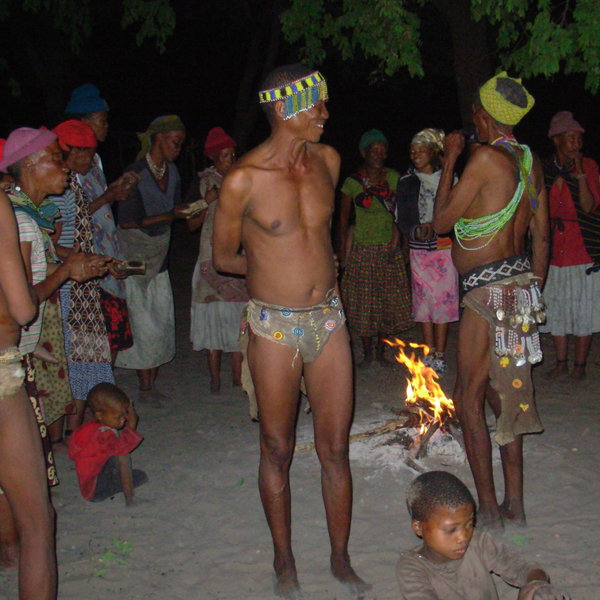
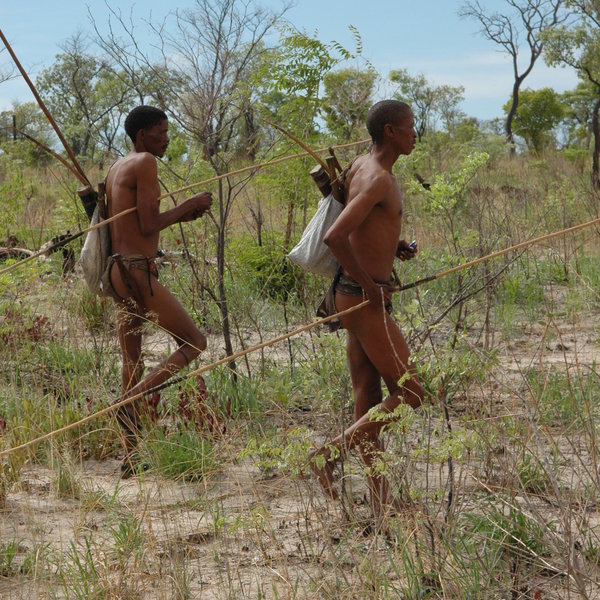
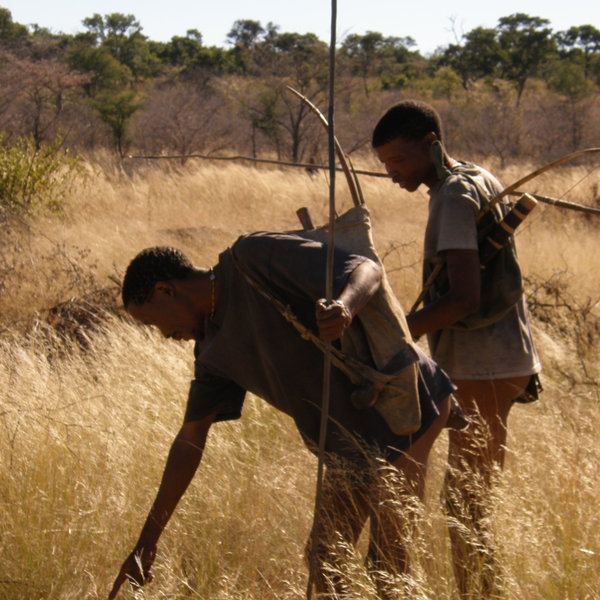
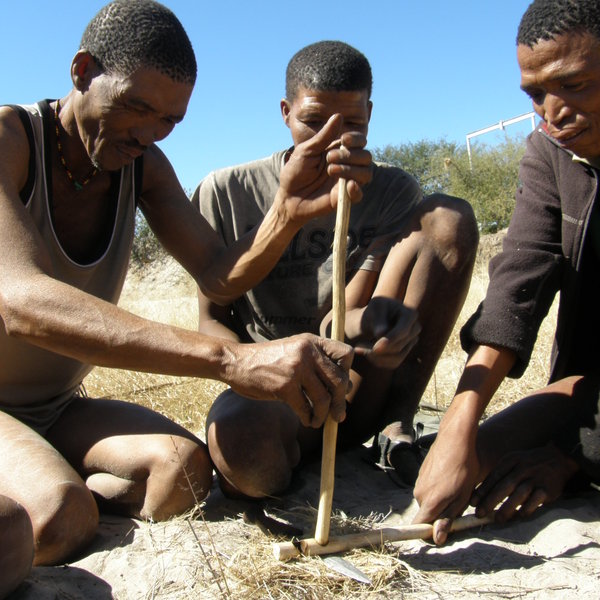
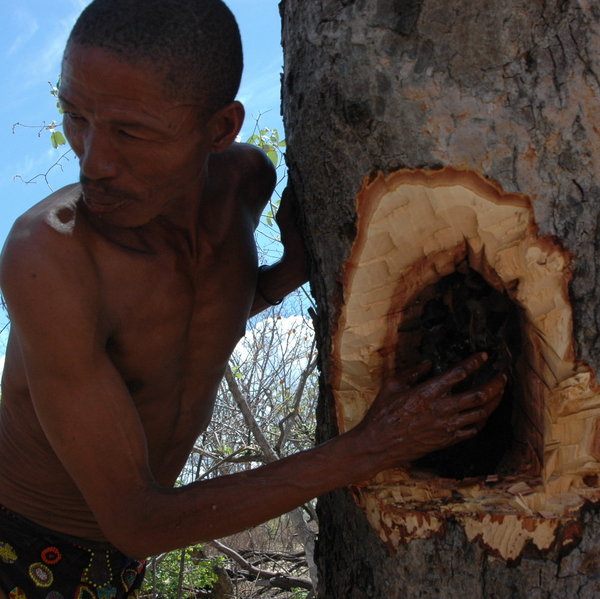
Expert Africa's gallery
When we travel we take lots of photos ourselves to give you a real and un-edited view of the safaris. See our 18 pictures of Nhoma Camp to get the candid view.
View gallerySafaris visiting Nhoma Camp
Just ideas, we'll always tailor-make a trip for you
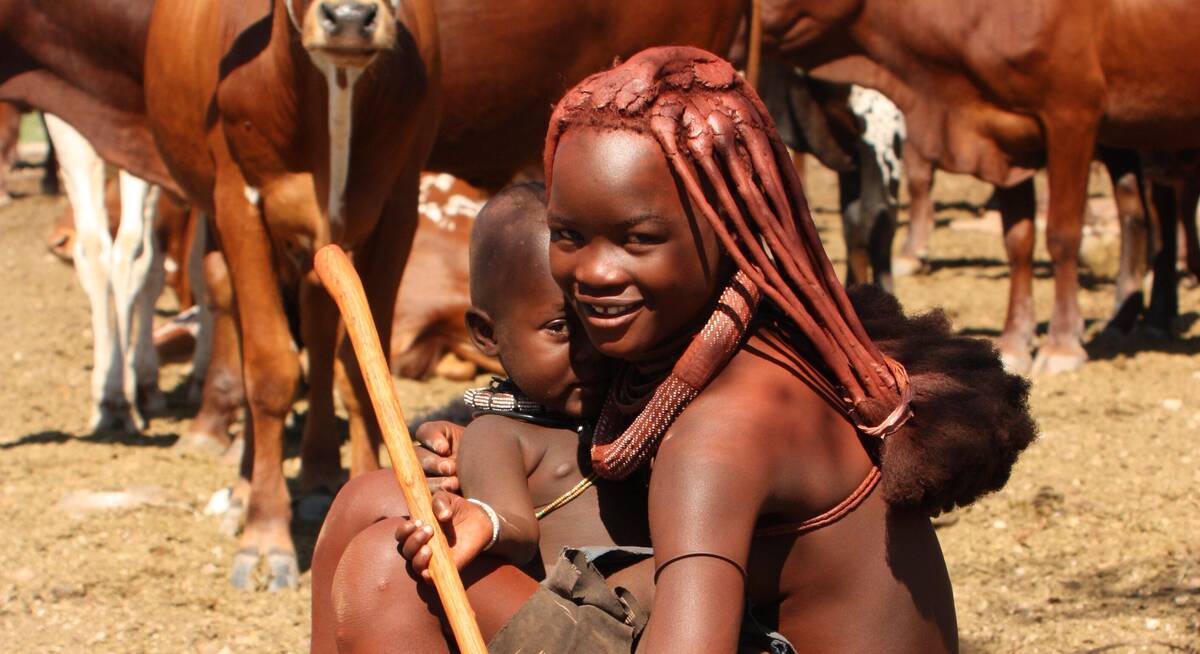
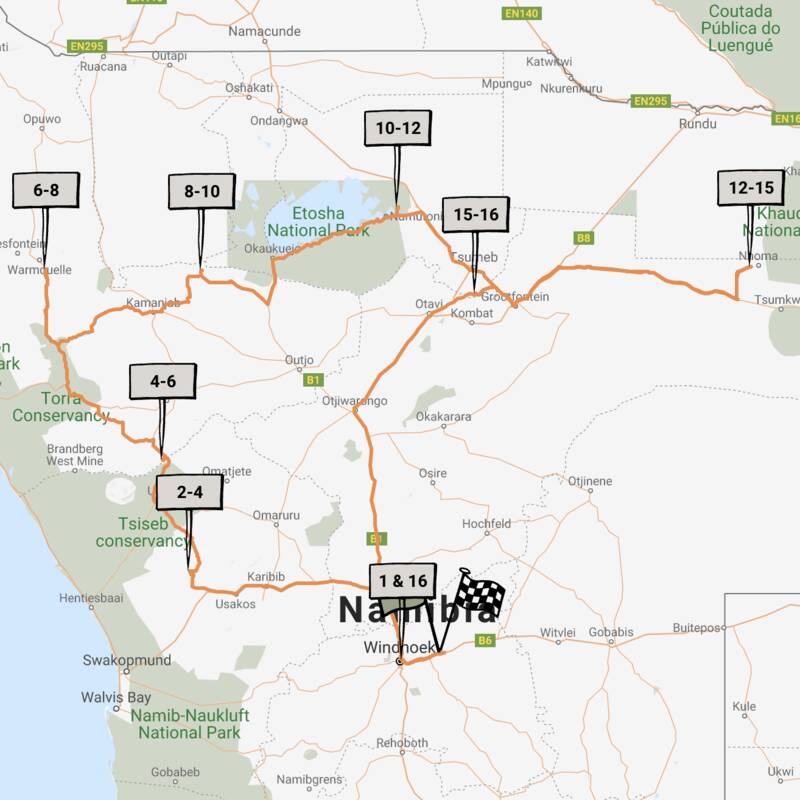
Hartebeest Self-drive Safari
16 days • 8 locations • 1 country
WINDHOEK AIRPORT TO WINDHOEK AIRPORT
This self-drive safari focuses on the best cultural experiences in Namibia. Visit a Himba village and enjoy three days living with the San Bushmen interspersed with some excellent wildlife watching.
Visiting Bushmanland, Central Highlands and 3 other areas
US$4,590 - US$4,860 per person
Nhoma Camp: Our full report
Nhoma Camp, located close to Khaudum National Park, is a small, tented camp in a remote area of north-eastern ...
... Kalahari, known as Bushmanland, which takes its name from the nearby village of //Nhoq'ma. New owners, Belgian Flora Blommaert and Namibian Moritz von Hase, took over from Arno and Estelle Oosthuysen in January 2021 and, together with their young child Indigo, have made Nhoma Camp their home and the Bushmen their business partners and neighbours.
Nhoma Camp and village is within Bushmanland adjoining the Nyae Nyae Conservancy, the home of the Ju/'hoansi Bushman. Established in 1998 at a size of about 9,000km², this conservancy encourages the Ju/'hoan people to hunt for food using their traditional sustainable methods and with tools created in the traditional way. The Bushmen also derive income from tourism in the area. A portion of your accommodation fee at Nhoma Camp goes directly to //Nhoq'ma Village.
Time at Nhoma Camp and with the Bushman that live here is truly a unique experience: and often an amazing one. Visitors can participate in day-to-day village life in a sensitive way. In addition, tourism has significantly helped //Nhoq'ma Village. Apart from their material gain, it has increased the importance that the people place on their own traditional skills and cultural heritage – as they now see these as passports to earning money, rather than as anachronisms.
Nhoma Camp has 10 tented rooms each built on wooden decks and with a delightfully simplicity and rustic feel – it's very close to the village. These are made up of a walk-in Meru-style tent, with an en-suite bathroom and private veranda. All the furniture is made with the help of the community; throw rugs cover the floor, and linens in creams and browns with a bushman motif cover the beds. We found these to be some of the most comfortable beds that we've ever slept on!
The camp is set on a hillside overlooking //Nhoq'ma Omarumba (river valley). It’s a classic Kalahari landscape of open woodlands standing on ancient sand dunes. At the highest point is the pole and thatch dining area, where tea and coffee is available throughout the day and buffet meals are served. Beyond this is the camp fire, a gathering point for pre- and post-dinner drinks and to discuss the day's experiences. Due to the lack of light pollution in the area, the night skies seen here are some of the clearest that you'll ever find.
Activities at Nhoma Camp centre around the Bushmen and the village. During a stay at Nhoma Camp, it is usual to spend most of your activities following the village's hunters and gatherers whose job it is to find food in the traditional way. What hunting and gathering activities are planned for the day, or indeed if one is planned, depends on recent events and what the village needs. The decision is made by the villagers. During our last visit, we spotted a porcupine on our way to camp and after telling the villagers, they decided to delay their plan to harvest a known bee nest and to track the porcupine instead.
An activity can last anything from two hours to most of the day. In our case, the porcupine eluded us. So after a few hours the Bushmen gave up and went in search of spring hare instead, a nocturnal rodent that sleeps in its burrow during the day. Depending on the needs of the villagers, it is possible that visitors staying a number of days, may be able to join a hunt for bigger game such as kudu or wildebeest. First you stalk the prey and shoot it with a poisoned arrow. Then you rest whilst the poison takes affect before you track it to where it has fallen – such a trek can take most of the day so a good level of fitness is recommended.
When following the hunters and gatherers, you'll always be accompanied by a guide; crucially he speaks Afrikaans and English, so can interpret what the hunters say. This is usually Moritz or Kaece G/aq'o (aka 'Bertus'), the son of one of the village's elders (now deceased). Along the way the Bushmen stop to point out various plants and explain their traditional use for food or medicine. This is often an interactive experience with the chance to taste or imitate.
Unlike activities at most conventional safari camps, where you go and what you see on these activities isn't determined by your wishes. The guide does not instruct the hunters and gatherers - instead, they carry on as they normally would – and you have the opportunity to either follow or, if it's particularly long and arduous, to turn back to camp with your guide.
The village eagerly awaits the return of the hunters and gatherers to see what they bring back. Afternoons are often spent here with the community watching them process any meat, honey, berries or nuts brought to the village. The villagers will also demonstrate the ancient skills of fire making, creating rope and setting traps. The woman and children will often initiate games such as the monkey orange game or hyena game. Games are usually accompanied by much merriment and singing.
During dinner at Nhoma Camp, singing is often heard coming from the village. If this happens, then visitors have the opportunity to wander over to the village, and watch dances performed by the Bushmen – like the traditional giraffe or elephant healing dance. If you are lucky, you will see one of the participants fall into a trance where he believes he is being spoken to by his ancestors. Again – these are activities are a part of village life and you have the opportunity to join in if you’d like.
Giving something back
The work Flora and Moritz are doing with //Nhoq'ma Village and the surrounding area is not charity work; they are business people and the camp is a commercial venture, albeit a small one. With Flora’s background in fine arts, she started a project with the Bushmen in 2015 to revive their traditional hunting sandal and, in 2017, moved to Nhoma to run a small-scale production business – “SAN-dal” – in partnership with the Bushmen.Visiting Nhoma Camp gives the //Nhoq'ma community a real income in an area where jobs and cash are very hard to find. The villagers are paid by the camp for allowing guests to accompany them as they go about their daily life. Having specifically asked the village elders about this, we were assured that the community is happy with how the arrangement works – and that's a large part of why we are happy to encourage our travellers to visit and support the Camp.
For anyone who wishes to help the village even further, Flora and Moritz run a small fund which is used in various ways to help the village, including school supplies, clothes for the children, blankets, mosquito nets and fire prevention in the surrounding area.
Our experience of Nhoma
We've been visiting Nhoma ourselves, and sending visitors to Nhoma for over ten years, and in that time, we've learnt a lot.We've found that the experience can be amazing, even life-changing, if you can put your inhibitions aside. It'll work best if you're happy to try to communicate – perhaps to use sign language and mime, to try everything that you're offered, to ask questions and to joke with the villagers. Then you'll usually find them to be very open, demonstrative and often very happy people who often use jokes to communicate a point, and who live very much in the present. Then, you may come away with everlasting memories from this incredible experience.
At its best, we rate the experience here as amongst the most impressive cultural experiences that we have experienced in Africa. It’s often difficult to have anything except very superficial experiences of traditional African cultures: we’ve seen enough excruciatingly embarrassing tribal dances across Africa to last a lifetime. In contrast: Nhoma offers something very rare – the time and opportunity to interact with people from a radically different culture, and to get to know them at least a little.
We've also found that often the Bushmen just don't understand, or relate well, to visitors who remain aloof, nervous or stand on the side lines. This kind of behaviour just isn't normal in their culture ... they don't know how to deal with it. So, if you come to Nhoma feeling insular, or you don't want to get involved, or interact ... then your time here could be quite disappointing.
Geographics
- Location
- Bushmanland, Namibia
- Ideal length of stay
- Ideally stay here for at least 2 nights in order to experience what is on offer.
- Directions
- About 60km north of Grootfontein turn east onto the C44 gravel road. After approximately 185km turn north at the sign that reads Nhoma/Aasvoelnes onto a relatively good track. From here it is 40km to Nhoma.
The last 40km to Nhoma Camp is sandy so only recommended for 4WD vehicles. If traveling in a 2WD vehicle arrangements can be made for a transfer from the main C44 road to the camp. - Accessible by
- Self-drive or Fly-and-Transfer
Food & drink
- Usual board basis
- Full Board & Activities
- Food quality
- The meals at Nhoma Camp are hearty and fresh. Don't expect gourmet food but you can expect fresh ingredients and a variety of dishes.
Breakfast is served as a buffet before the morning activity. This usually includes cereals, fruit, yoghurt, juice, toast, eggs, bacon and porridge with tea and coffee (filter or instant).
Selections of cold dishes are usually served for lunch. Home-made bread is accompanied by salads such as tuna, cheese and tomato or bean salad and cold meats such as ham and chicken legs.
Dinner is usually a choice of meat, vegetables, starches and salads. During our stay we had lamp chops with baked potatoes, polenta and salad on one night and Eland steaks with mushroom sauce, corn on the cob, rice, vegetables and salad on the second. After the meal we recommend you say “yes" to one of Arno's delicious Amarula coffees! - Dining style
- Group Meals
- Dining locations
- Outdoor Dining
- Further dining info, including room service
- The morning wake up call is accompanied by your choice of tea or coffee.
- Drinks included
- A good range of beverages are available and included in the price. There is a choice of water, soft drinks, juices, wines, beers and local spirits such as gin and whisky.
Special interests
- Family holidays
- Meeting Bushmen near Nhoma Camp is a sensitive, authentic insight into a fascinating culture and the bush. We highly recommend Nhoma Camp and Bushmanland for Namibia family safari holidays with interested, adventurous and enthusiasic children of all ages, ideally 8+.
- See ideas for Family holidays in Namibia
- Cultural Experiences
- At Nhoma Camp you're staying right by a Bushmen village. Here, the Ju/'hoan people have been a part of the camp's setup from the beginning, and benefit substantially from your visit. Time with these people offers amazing insights into a hunter-gatherer culture.
- See ideas for Cultural Experiences in Namibia
Children
- Attitude towards children
- Children of all ages are welcome at Nhoma Camp.
- Generally recommended for children
- We can highly recommend Nhoma Camp and Bushmanland to families with interested and enthusiastic children of all ages. Not only is this a wonderful, genuine cultural experience for everyone, but the bush is a virtual classroom offering countless opportunities for new experiences.
Our travellers’ wildlife sightings from Nhoma Camp
Since mid-2018, many of our travellers who stayed at Nhoma Camp have kindly recorded their wildlife sightings and shared them with us. The results are below. Click an animal to see more, and here to see more on our methodology.

60% success

60% success

60% success

40% success

40% success

40% success

20% success

20% success

20% success

20% success

0% success

0% success

0% success

0% success
Communications
- Communications
- Communications with Nhoma Camp are erratic. Sometimes there is cell phone reception around the camp, at other times there isn’t. WiFi is available in the camp's main area. There is also a charging station in the main area for guest's use.
- TV & radio
- There are no TVs or radios here - it feels as if you're a long way from anywhere ... and you are!
- Water supply
- Borehole
Health & safety
- Malarial protection recommended
- Yes
- Medical care
- There’s a simple clinic in Tsumkwe, and an hour’s drive away Mangetti Hospital often has a doctor on site. However, if you encounter any serious medical issues, then it’s best to use your travel insurance and go to the private hospital in Grootfontein – about three and a half hours' drive away.
- Dangerous animals
- High Risk
- Security measures
- Walking activities at Nhoma Camp: The guides at Nhoma, and their ancestors, have lived here in the Kalahari for millennia. For most of that history, the Bushmen have hunted and gathered to survive – giving them an exceptional appreciation of their natural environment, and understanding of the animals within it. However, even with this, they are not immune from the dangers of the bush. Although they understand the wildlife well, and the risks, it’s always possible for them to be surprised by dangerous animal and for accidents to occur.
Where our travellers go walking in Africa in areas of big game, safety concerns dictate that they will often be accompanied by an armed guide. This isn’t how the walks at Nhoma are conducted: they are led by bushman trackers, none of whom will carry a rifle. We are happy to recommend these walks as fascinating experiences. However, all travellers need to understand that no walk in the bush is without its risks, even when you are being led by people who have been born and brought up in this environment.
You should only come to Nhoma if you are happy to accept the inherent risks of living and moving around in such a wild area, as the Bushman do. - Fire safety
- The camp team, with the help of the community, regularly maintain fire breaks around the camp in case of bush fire.
Activities
4WD Safari
Birdwatching
Cultural excursion
Private activities
Extras
- Disabled access
- Not Possible
- Laundry facilities
- A laundry service is included. Please be aware that clothes are hand washed and will not be ironed.
- Accepted payment on location
- All forms of cash currency are accepted at Nhoma Camp. Payment is not possible by credit card.
Plan and book your trip with Expert Africa
All of our trips are tailor-made, so we'll always adapt them to suit you. Talk to an Expert and let us plan and arrange your perfect trip.

Talk to an Expert
Call or email us now! We’ll match you with the Specialist in our team who is best suited to help you. Then together we can start planning your trip.

Set up your itinerary
Based on our experience and your ideas, your specialist will create a detailed, costed itinerary. We’ll refine it together, until we have a trip that you’re perfectly happy with.

Prepare for your trip
The same Specialist will make the seamless arrangements for your trip, send you detailed travel documents, and be available to answer any questions before you depart.

Travel with peace of mind
After you set off, you’ll be cared for by our partners in Africa, most of whom have worked with Expert Africa for decades. And if you ever need us urgently, we’re available 24/7.

When you return
We love to learn about your trip, and so will always be grateful if you’ve the time to give feedback to your Specialist when you return.
Nhoma Camp's location
Look closer at the environment and surroundings of Nhoma Camp.
When to go to Bushmanland
Our month by month guide: What it's like to visit Nhoma Camp in Bushmanland
Jan
Feb
Mar
Apr
May
Jun
Jul
Aug
Sep
Oct
Nov
Dec
Namibia in January
January is at the heart of Namibia’s rainy season. However, as you’d expect from a country dominated by desert and semi-desert environments, the rains are often (but not always) weak and usually quite localised. Some days will be clear, the strong sun raising temperatures to around 30ºC/86ºF; on others humidity and clouds build, sometimes culminating in spectacular thunderstorms. In extreme cases, these generate flash-floods which race down the beds of ephemeral rivers.
Across the country, the greening landscape makes a refreshing change, especially in desert areas. Many birds are in full breeding plumage and migrant species are here in force. In the north, where the rains are more reliable, the abundant water and food allows wildlife to disperse, making it trickier to spot.
- Variable weather: clear, hot & dry, or cloudy & humid with some rain
- Occasional, highly localised thunderstorms
- Many animals with young; birdlife at its most spectacular
- Wildlife dispersed & harder to see, especially in Etosha & the Caprivi
- Very few tourists (apart from the New Year) so rates mostly low
Our view
This is not a great time to visit
Weather in January
Namibia in February
February is the wettest month, but as Namibia is dominated by deserts, the rains are often weak and patchy. The variation in weather across Namibia is significant, too; the central highlands and Caprivi can see some heavy rain. More typically, some February days are clear with a hot, strong sun; others are cooler as cloudy skies build and, sometimes, culminate in short, spectacular thunderstorms. Occasionally these generate flash-floods, bringing ephemeral rivers to life and making travel more challenging.
Across the country, the landscape feels green and alive; insects and smaller animals are more easily seen, and many birds and animals are raising their young. However, small pools in the bush and thicker vegetation can make it hard to spot the wildlife.
- Variable weather: clear, hot & dry or cloudy & humid with some rain
- Occasional localised thunderstorms meander over the landscape
- The bush feels alive; birdlife is at its most spectacular
- Wildlife in Etosha & Caprivi is dispersed & harder to see
- Few tourists, so rates usually at their lowest
Our view
This is not a great time to visit
Weather in February
Namibia in March
March usually sees Namibia’s main rains tailing off, although actual precipitation varies hugely across the country and can be unpredictable from day to day. Many days will be clear, with a strong sun driving temperatures up. On others, clouds will build, and the late afternoon may see a short, spectacular thunderstorm. Such deluges reduce in both frequency and volume as the month progresses.
Across the country, landscapes are often vivid: a “green and pleasant land”. Many birds and animals are finishing raising their young, so smaller animals and insects are in evidence. In the north, where rains are generally heavier, pools in the bush and thicker vegetation can make it difficult to spot larger animals.
- Variable weather: clear, hot & dry or cloudy & humid with some rain
- Afternoon thunderstorms less common as March progresses
- Animals looking sleek and well-fed, after 3–4 months of plenty
- Wildlife in Etosha & Caprivi is dispersed & harder to see
- Few tourists visit during March, so rates often low
Our view
A good time to visit, with pros & cons
Weather in March
Namibia in April
Typically, April is dominated by dry weather; there’s an ever-decreasing chance of rain. Temperatures are now below their peak and continue to fall. Even so, days remain pleasant and warm, but there might be a slight chill in the air at night. The rains usually leave many parts of the country verdant and green, so animals are in fantastic condition – often with fast-growing young in attendance.
With the dust washed out of the atmosphere, photographers make the most of clear air, spectacular landscapes and healthy animals. Stargazers will have clearer night skies as the month progresses. In the game parks of Northern Namibia, water and food remain in plentiful supply, so finding big game can prove trickier than later in the year.
- Becoming drier &, especially at night, also cooler
- Few visitors, except around Easter, so rates remain low
- Wildlife in Etosha & Caprivi remains relatively hard to see
- Migrant birds have started to leave
- Fresh, clean air and often green, verdant landscapes
Our view
A good time to visit, with pros & cons
Weather in April
Namibia in May
By May, Namibia is usually drying out fast as the rains have ended. If they’ve been good, then the land remains green, but wildlife starts to congregate at more permanent water sources. Over much of the country the air quality and clarity can be amazing, making this an ideal month for photography.
Typical days are warm, with crisp, clear mornings and clear blue skies. Evenings are usually cool, and temperatures may dip below 10ºC (50ºF) overnight. Many lodges still charge “low season” prices, although with Namibia’s increasing popularity in recent years, some have started to introduce higher “shoulder season” rates.
May’s good-value rates, increasingly good wildlife sightings, beautiful landscapes and crystal-clear air combine to make this one of our favourite months in Namibia.
- Lovely weather: dry, warm days & cool nights
- The country is drying out although many landscapes remain green
- Fantastic air clarity – ideal for keen photographers
- Visitor numbers are often still low, mirrored by lodge rates
- Wildlife is starting to congregate more around remaining water
Our view
A very good time to visit
Weather in May
Namibia in June
Namibia is dry again. Skies are blue and usually largely cloudless. Days are lovely: warm and dry; nights are cold, sometimes below freezing in the desert. Most swimming pools in Namibia are always outdoors, making them too cold for all except the very dedicated.
Take a warm hat and gloves for game drives, where dawn and dusk will feel particularly chilly. In the north, especially Etosha, wildlife viewing is now into its dry-season pattern, focusing around the waterholes – though the park is still not busy.
Photographers come for superb air clarity, with minimal dust or smoke in the air. Historically, June rates have been low. However, with Namibia’s increasing popularity many lodges now count it amongst their “high-season” months, and request higher prices.
- Clear, bright days with blue skies; cold nights, mornings & evenings
- Great air quality, especially welcome for photographers
- “Shoulder season” for some lodges: lodge rates moderate
- Wildlife gravitates to waterholes, making game-viewing productive
- Some greenery in the landscape, depending on the last rains
Our view
A very good time to visit
Weather in June
Namibia in July
Reliably warm daytime temperatures (upwards of 20ºC/70ºF) and good wildlife sightings make this a popular month to visit Namibia. Rain would be very unusual indeed and clear skies make for great photographs. Once the sun sets, though, temperatures cool rapidly bringing cold nights that may dip below freezing in the desert. Be prepared: dress in layers and expect early-morning and late-afternoon drives, and anywhere coastal, to be cold.
As the land dries and vegetation shrivels, game congregates beside drinking water: Etosha’s waterholes are busy with animals. Across the country, lodges charge “high season” rates; many are fully booked a year or more in advance, especially during European school holidays (from the latter half of July to late August).
- Dry days, warm in the sun, with crisp, cold nights
- Cloudless skies: July is usually superb for stargazing
- The beginning of European school holidays so more families travelling
- Peak season: so high rates and many lodges fully booked far in advance
- A fantastic time of year for wildlife watching, particularly in Etosha
Our view
A very good time to visit
Weather in July
Namibia in August
August is the height of Namibia’s “winter”. Expect cloudless skies and plenty of warm sun in the day, but nights down to freezing in the desert. Dress in layers and bring warm clothes (including hats and gloves) for chilly starts and evenings. Only the hardiest even contemplate using outdoor pools.
It’s 3–4 months since any rain, so the land is dust-dry and much vegetation is golden brown. Many landscapes appear sparse and harsh. Wildlife congregates around available water sources, helping to guarantee good animal sightings.
Namibia is never really “busy” by the standards of Europe or the USA, but August is the most popular time to visit, especially for families. Book early (over a year in advance) if you want to stay at the best lodges.
- Dry days, warm in the sun; cold mornings, evenings & nights
- Cloudless skies in the day; spectacular stars at night
- Busy by Namibian standards: family rooms in particular demand
- Peak season: so high rates and many lodges fully booked far in advance
- A fantastic time of year for wildlife watching, particularly in Etosha
Our view
Fantastic: the very best time to visit
Weather in August
Namibia in September
September is a month of blue, cloudless skies and fantastic wildlife viewing. Rain is almost unheard of. As the month progresses, the days and nights get warmer. In some areas, daily maximums hit around the low 30s Celsius, although low humidity ensures this feels comfortable. The contrast makes the nights seem very cold. The air is becoming dustier, occasionally augmented by smoke from fires – so becoming hazy for photographic purists.
In the national parks, animals congregate around remaining water sources – making September one of the best months for game viewing. Hence it’s one of Namibia’s most popular months for visitors: a “high season” month that is often the time of choice for safari aficionados.
- One of the best months for wildlife viewing
- Warm days & cold nights, with temperatures rising during the month
- Many plants have faded from green to golden brown
- Air can be hazy – with dust & sometimes smoke
- High season rates; many lodges & camps are full 9 months in advance.
Our view
Fantastic: the very best time to visit
Weather in September
Namibia in October
Namibia is usually at its hottest and driest in October. Temperatures build as the month progresses; towards the end, daily highs may exceed 40ºC/100ºF, though with humidity close to zero, even this rarely feels oppressive.
In exceptional years, isolated rain showers may fall in late October. More usually, the end of the dry season sees wildlife watching at its best, particularly in Etosha. The place feels like a desert as spectacular herds of thirsty animals gather around the available water. October is popular amongst wildlife enthusiasts and commands peak-season prices, even if dust and smoke may make the air hazy, challenging photographers. Visitor numbers can fade towards the end of the month, allowing a window for last-minute bookings.
- Probably the most spectacular month for wildlife-viewing in Etosha
- Hot and dry: much of the country feels like a desert
- The air can be hazy with dust & smoke
- It’s peak time to visit, so expect high season rates
- Lodges & camps are full, especially early in October
Our view
A very good time to visit
Weather in October
Namibia in November
November is always a bit unpredictable: sometimes dry and hot; sometimes cloudier and cooler. Typically, mornings are hot and cloudless and clouds appear in the afternoon. Humidity builds and eventually breaks, resulting in spectacular thunderstorms that bring convection rainfall in late afternoons. Such storms are typically sparsely distributed and highly local – being completely absent from desert areas, for example. Places that do get good rain will flush green, with a tangible feeling of new life softening the landscapes. Many mammals give birth to their young.
Once any rains come, wildlife dissipates in search of food, and game viewing in Etosha becomes harder. Conversely, this is a great time for birdwatchers, with migrant species in breeding plumage.
- A very interesting, variable month, depending on the rains
- With rains come an amazing explosion of both vegetation & new life
- Wildlife viewing better in Damaraland than Etosha if it has rained
- Shoulder season: mid-range rates offer great value
- Away from the Namib, showers are more likely later in the month
Our view
A good time to visit, with pros & cons
Weather in November
Namibia in December
December is the first “proper” month of Namibia’s rainy season, and one of its hottest. Clear mornings give way to building clouds and, with luck, the occasional short, spectacular thunderstorm: refreshing and cleansing. These are often highly localised and generally warmly welcomed: most Namibians love rain!
Rains clear the air of dust. Even relatively short showers enable plant life to erupt, carpeting this thirstland in green and providing food for the young animals which abound. Animals disperse widely, which can make game viewing challenging. Many birds are breeding and so sporting their most colourful plumage.
Christmas and the New Year fall within local “summer holidays” – so places to stay can be surprisingly busy, especially in and around coastal towns, where temperatures are cooler.
- Hot and humid; sometimes refreshed by cooling showers
- Landscapes flushed green if/where there has been rain
- A tangible life and energy amidst this often green & pleasant land
- Very photogenic: blooming deserts amidst crystal-clear air
- Best time for birdwatchers; larger animals harder to spot
Our view
This is not a great time to visit
Weather in December

Looking for inspiration on where to travel next?
Visit our trip chooser to explore your options and find inspiration for your perfect African adventure
Inspire me